A New Methodology for Optimising Railway Line Capacity: Improving Infrastructure for Sustainable Transport
Abstract
1. Introduction
2. State-of-the-Art
3. Materials and Methods
- A—The analysis period defines the duration of the assessment phase, which is used to ascertain the number of trains and capacity [h];
- ND9—The ninth decile of the number of trains in the critical section. The ninth decile (D9) is defined as the value below which 90% of all data points in the set fall. In other words, 90% of the values observed are lower than or equal to this value, and only 10% of the values are higher. It represents the value of the ninth decile of the daily number of trains, ranked from highest to lowest [-];
- d—The item corresponding to the ninth decile is ordered as follows [-]:
- a—The length of the observation period is defined as the number of days over which the observation is conducted [-];
- NVYHL—The prospective number of trains for the period (the expected number of trains for the period) [-];
- b—Unit occupation time [min];
- bn—The most unfavourable journey time is the highest journey time observed in the critical section of the sub-track. If the highest journey time differs significantly from the others, the next journey time in order from the highest is used as the reference point [min];
- n—Infrastructural capacity is defined as the number of feasible journeys that can be accommodated on a given infrastructure within a specified time period. The relation between capacity and unit occupancy time over the course of a one-hour monitoring period is pictured in Figure 1 [-];
- k—Step of unit occupation time by which the unit occupation time is gradually reduced. The value of this variable can be arbitrarily small (which makes it possible to obtain a value of utilisation closer to the desired utilisation), but in the reality of railways and timetabling, values of 0.5 or 1 min are appropriate [min];
- Kp—Target capacity utilisation—targeted utilisation for a given line segment. The valuation is determined with the aim of ensuring compliance with the relevant regulatory framework. Furthermore, it is also intended to establish a certain reserve [-].
4. Calculation
- K—Capacity utilisation—the ratio of the number of journeys to the total capacity over a specified time period [-];
- KVYHL—Capacity utilisation of current infrastructure with the prospective number of trains—the utilisation of the capacity for the expected number of trains on the existing infrastructure. This formula is based on inserting the formula for capacity n into the formula for capacity utilisation K, where the reference number of trains is the prospective number of trains NVYHL [-];
- Kb—Capacity utilisation for the given occupation time, with the prospective number of trains—is used to calculate the capacity utilisation for different values of b, which are successive with a distance between them determined by the value of k [-];
- blim—Limiting journey time—a value of a journey time b in minutes, beyond which it is necessary to implement infrastructure measures. The value of this variable is defined by the relation of Kb ≤ Klim, which must be respected to ensure that the infrastructure meets the future demands placed on it and has sufficient capacity headroom to allow for traffic development [min].
- division of the line into segments;
- determination of the limiting journey time for each segment;
- identification of an infrastructure measure to increase capacity.
4.1. Division of the Line into Segments
4.2. Determination of the Limiting Journey Time for a Segment
4.3. Identification of an Infrastructure Measure to Increase Capacity
- Division of the track section into discrete block sections;
- Division of the line with a track branching (station, passing loop);
- Increasing the number of tracks (double tracking).
5. Results
6. Discussion
7. Conclusions
- Segmentation of the railway line—the initial step in this process is the division of the railway line into segments, with the basis of this division being the similarity of traffic volumes. This segmentation uses a moving average, with each segment comprising several connected line sections. This division is of crucial importance to identify areas in which infrastructure improvements are most required.
- Determination of limiting journey times—the subsequent stage of the process is to calculate the limiting journey times for each segment. The segment with the longest journey time (occupancy time) is identified first. The second-longest value is chosen if there are significant differences in journey times. This limiting time is progressively reduced to achieve the desired capacity utilisation for the expected number of trains. Based on this, the maximum acceptable travel times are determined for each segment.
- The identification of infrastructure improvements—the methodology was developed to facilitate the identification of critical sections of the railway line where infrastructure improvements are necessary. These improvements may include dividing the track into discrete block sections, adding track branches such as stations or passing loops, or increasing the number of tracks. These measures are proposed for sections where journey times exceed the limiting value, ensuring that the railway system can meet future demands effectively and efficiently.
Author Contributions
Funding
Institutional Review Board Statement
Informed Consent Statement
Data Availability Statement
Conflicts of Interest
References
- Ljubaj, I.; Mikulčić, M.; Mlinarić, T.J. Possibility of Increasing the Railway Capacity of the R106 Regional Line by Using a Simulation Tool. Transp. Res. Procedia. 2020, 44, 137–144. [Google Scholar] [CrossRef]
- Abril, M.; Barber, F.; Ingolotti, L.; Salido, M.A.; Tormos, P.; Lova, A. An assessment of railway capacity. Transp. Res. Part E Logist. Transp. Rev. 2008, 44, 774–806. [Google Scholar] [CrossRef]
- Khadem Sameni, M.; Moradi, A. Railway capacity: A review of analysis methods. J. Rail Transp. Plan. Manag. 2022, 24, 100357. [Google Scholar] [CrossRef]
- Francesco, R.; Gabriele, M.; Stefano, R. Complex railway systems: Capacity and utilisation of interconnected networks. Eur. Transp. Res. Rev. 2016, 8, 29. [Google Scholar] [CrossRef]
- Landgraf, M.; Zeiner, M.; Knabl, D.; Corman, F. Environmental impacts and associated costs of railway turnouts based on Austrian data. Transp. Res. Part D Transp. Environ. 2022, 103, 103168. [Google Scholar] [CrossRef]
- Giunta, M. Trends and Challenges in Railway Sustainability: The State of the Art regarding Measures, Strategies, and Assessment Tools. Sustainability 2023, 15, 16632. [Google Scholar] [CrossRef]
- Kljaić, Z.; Pavković, D.; Cipek, M.; Trstenjak, M.; Mlinarić, T.J.; Nikšić, M. An Overview of Current Challenges and Emerging Technologies to Facilitate Increased Energy Efficiency, Safety, and Sustainability of Railway Transport. Future Internet 2023, 15, 347. [Google Scholar] [CrossRef]
- Guerrero-Bustamante, O.; Guillen, A.; Moreno-Navarro, F.; Rubio-Gámez, M.C.; Sol-Sánchez, M. Toward sustainable railway track foundation: Recycling RAP from road asphalt pavements: Recycling RAP from road asphalt pavements. Constr. Build. Mater. 2024, 439, 137436. [Google Scholar] [CrossRef]
- Zhou, F.; Tang, Z.; Tan, D.; Xie, Y. Capacity configuration optimization of regenerative braking energy utilization system for electrified railways based on power sharing and energy storage. Electr. Power Syst. Res. 2025, 239, 111275. [Google Scholar] [CrossRef]
- Ortega Riejos, F.A.; Barrena, E.; Canca Ortiz, J.D.; Laporte, G. Analyzing the theoretical capacity of railway networks with a radial-backbone topology. Transp. Res. Part A Policy Pract. 2016, 84, 83–92. [Google Scholar] [CrossRef]
- Burkhalter, M.; Adey, B.T. Assessing the Effects of Closure-Free Periods on Railway Intervention Costs and Service. J. Infrastruct. Syst. 2022, 28, 04022015. [Google Scholar] [CrossRef]
- de Weert, Y.R.; Gkiotsalitis, K.; van Berkum, E.C. Improving the scheduling of railway maintenance projects by minimizing passenger delays subject to event requests of railway operators. Comput. Oper. Res. 2024, 165, 106580. [Google Scholar] [CrossRef]
- Gan, M.; Li, D.; Yao, Z.; Yu, H.; Ou, Q. Intelligent decision modeling for optimizing railway cold chain service networks under uncertainty. Inf. Sci. 2024, 679, 121112. [Google Scholar] [CrossRef]
- Burdett, R.L. Optimisation models for expanding a railway’s theoretical capacity. Eur. J. Oper. Res. 2016, 251, 783–797. [Google Scholar] [CrossRef]
- Rais, N.M.; Jaafar, H.S.; Samsudin, M.R.H.; Rahman, H.A.; Towel, R.M.; Burhanuddin, S.N.Z.A. Measuring railway track capacity and utilization for KERETAPI tanah melayu berhad (ktmb). Adv. Transp. Logist. Res. 2020, 3, 908–916. [Google Scholar]
- Eliasson, J.; Börjesson, M. On timetable assumptions in railway investment appraisal. Transp. Policy 2014, 36, 118–126. [Google Scholar] [CrossRef]
- Jovanović, P.; Pavlović, N.; Belošević, I.; Milinković, S. Graph coloring-based approach for railway station design analysis and capacity determination. Eur. J. Oper. Res. 2020, 287, 348–360. [Google Scholar] [CrossRef]
- Mussone, L.; Wolfler Calvo, R. An analytical approach to calculate the capacity of a railway system. Eur. J. Oper. Res. 2013, 228, 11–23. [Google Scholar] [CrossRef]
- Ekman, J.K. A tool for analysis of railway capacity. In WIT Transactions on Modelling and Simulation; WIT Press: Southampton, UK, 2011; pp. 693–702. Available online: http://urn.kb.se/resolve?urn=urn:nbn:se:ri:diva-23904 (accessed on 26 May 2011).
- Rotoli, F.; Ricci, S. Methodological Review for Capacity and Punctuality Assessment Procedures. Int. J. Railw. Res. 2014, 1, 31–47. Available online: http://ijrare.iust.ac.ir/article-1-55-en.html (accessed on 19 October 2024).
- Zhang, C.; Gao, Y.; Cacchiani, V.; Yang, L.; Gao, Z. Train rescheduling for large-scale disruptions in a large-scale railway network. Transp. Res. Part B Methodol. 2023, 174, 102786. [Google Scholar] [CrossRef]
- Bulíček, J.; Nachtigall, P.; Široký, J.; Tischer, E. Improving single-track railway line capacity using extended station switch point area. J. Rail Transp. Plan. Manag. 2022, 24, 100354. [Google Scholar] [CrossRef]
- Quaglietta, E. A simulation-based approach for the optimal design of signalling block layout in railway networks. Simul. Model. Pract. Theory. 2014, 46, 4–24. [Google Scholar] [CrossRef]
- Zhong, Q.; Xu, R. Analytical railway line capacity methods from graph-theoretical and polyhedral perspectives. Transp. A Transp. Sci. 2024, 2414224. [Google Scholar] [CrossRef]
- Emunds, T.; Nießen, N. Evaluating railway junction infrastructure: A queueing-based, timetable-independent analysis: A queueing-based, timetable-independent analysis. Transp. Res. Part C Emerg. Technol. 2024, 165, 104704. [Google Scholar] [CrossRef]
- Weik, N.; Niebel, N.; Nießen, N. Capacity analysis of railway lines in Germany–A rigorous discussion of the queueing-based approach. J. Rail Transp. Plan. Manag. 2016, 6, 99–115. [Google Scholar] [CrossRef]
- Burdett, R.L. Multi-objective models and techniques for analysing the absolute capacity of railway networks. Eur. J. Oper. Res. 2015, 245, 489–505. [Google Scholar] [CrossRef]
- Gašparík, J.; Abramović, B.; Halás, M. New Graphical Approach to Railway Infrastructure Capacity Analysis. Promet-Traffic Transp. 2015, 27, 283–290. [Google Scholar] [CrossRef]
- Správa Železnic, Státní Organizace. Portál Provozování Dráhy. Available online: https://provoz.spravazeleznic.cz/Portal/ (accessed on 10 November 2024).
- SŽDC SM124 Zjišťování kapacity dráhy (SŽDC directive SM124 Track Capacity Assessment). 2019. Available online: https://www.spravazeleznic.cz/documents/50004227/139626480/SZDC_SM124_20190611.pdf/25a3553c-429d-4cc8-b17a-f27c501953f7?version=24.0. (accessed on 10 November 2024).
- Huber, H.P.; Herbacek, R. UIC Leaflet 406–Capacity, New Release. 2012. Available online: https://www.witpress.com/Secure/elibrary/papers/CR08/CR08006FU1.pdf (accessed on 20 October 2024).
- Zhong, Q.; Xu, C.; Yang, R.; Zhong, Q. Equivalences between analytical railway capacity methods. J. Rail Transp. Plan. Manag. 2023, 25, 100367. [Google Scholar] [CrossRef]
- Min, K.K.; Suk-Mun, O.; Suk-Joon, K.; Hwan, P.B. New Headway-Based Analytical Capacity Model Considering Heterogeneous Train Traffic. J. Transp. Eng. Part A Syst. 2020, 146, 04020135. [Google Scholar] [CrossRef]
- Haalboom, D.; Bešinović, N. Freight train scheduling for industrial lines with multiple railway undertakings. J. Rail Transp. Plan. Manag. 2024, 31, 100466. [Google Scholar] [CrossRef]
- Szymula, C.; Bešinović, N.; Nachtigall, K. Quantifying periodic railway network capacity using petri nets and macroscopic fundamental diagram. Transp. Res. Part C Emerg. Technol. 2024, 158, 104436. [Google Scholar] [CrossRef]
- Jansen, D.N.; Klabes, S.G.; Wendler, E. The impact of GSM-R on railway capacity. WIT Trans. State Art Sci. Eng. 2008, 46, 143–151. [Google Scholar] [CrossRef]
- Ranjbar, V.; Olsson, N.O.E.; Sipilä, H. Impact of signalling system on capacity–Comparing legacy ATC, ETCS level 2 and ETCS hybrid level 3 systems. J. Rail Transp. Plan. Manag. 2022, 23, 100322. [Google Scholar] [CrossRef]
- Cuppi, F.; Vignali, V.; Lantieri, C.; Rapagnà, L.; Dimola, N.; Galasso, T. High density European Rail Traffic Management System (HD-ERTMS) for urban railway nodes: The case study of Rome: The case study of Rome. J. Rail Transp. Plan. Manag. 2021, 17, 100232. [Google Scholar] [CrossRef]
- Široký, J.; Nachtigall, P.; Tischer, E.; Gašparík, J. Simulation of Railway Lines with a Simplified Interlocking System. Sustainability 2021, 13, 1394. [Google Scholar] [CrossRef]
- Vyhnanovský, M. Návrh Dopravní Technologie na Trati Havlíčkův Brod—Znojmo. Ph.D. Thesis, Faculty of Transport Engineering, University of Pardubice, Pardubice, Czech Republic, 2024. Available online: https://theses.cz/id/fnsrpo/ (accessed on 1 July 2024).
- Liu, J.; Chen, L.; Roberts, C.; Nicholson, G.; Ai, B. Algorithm and peer-to-peer negotiation strategies for train dispatching problems in railway bottleneck sections. IET Intell. Transp. Systems. 2019, 13, 1717–1725. [Google Scholar] [CrossRef]
- Cecchetti, G.; Ruscelli, A.L.; Ulianov, C.; Hyde, P.; Liu, J.; Magnien, A.; Tavač, M.; Ďuračík, M.; Oneto, L.; Bertolin, J. Toward new generation railway Traffic Management Systems: The contribution of the OPTIMA project. Transp. Res. Procedia 2023, 72, 3166–3173. [Google Scholar] [CrossRef]
- Liu, J.; Ulianov, C.; Hyde, P.; Ruscelli, A.L.; Cecchetti, G. Novel approach for validation of innovative modules for railway traffic management systems in a virtual environment. Proc. Inst. Mech. Eng. Part F J. Rail Rapid Transit. 2022, 236, 139–148. [Google Scholar] [CrossRef]
- Liu, J.; Lin, Z.; Liu, R. A reinforcement learning approach to solving very-short term train rescheduling problem for a single-track rail corridor. J. Rail Transp. Plan. Manag. 2024, 32, 100483. [Google Scholar] [CrossRef]
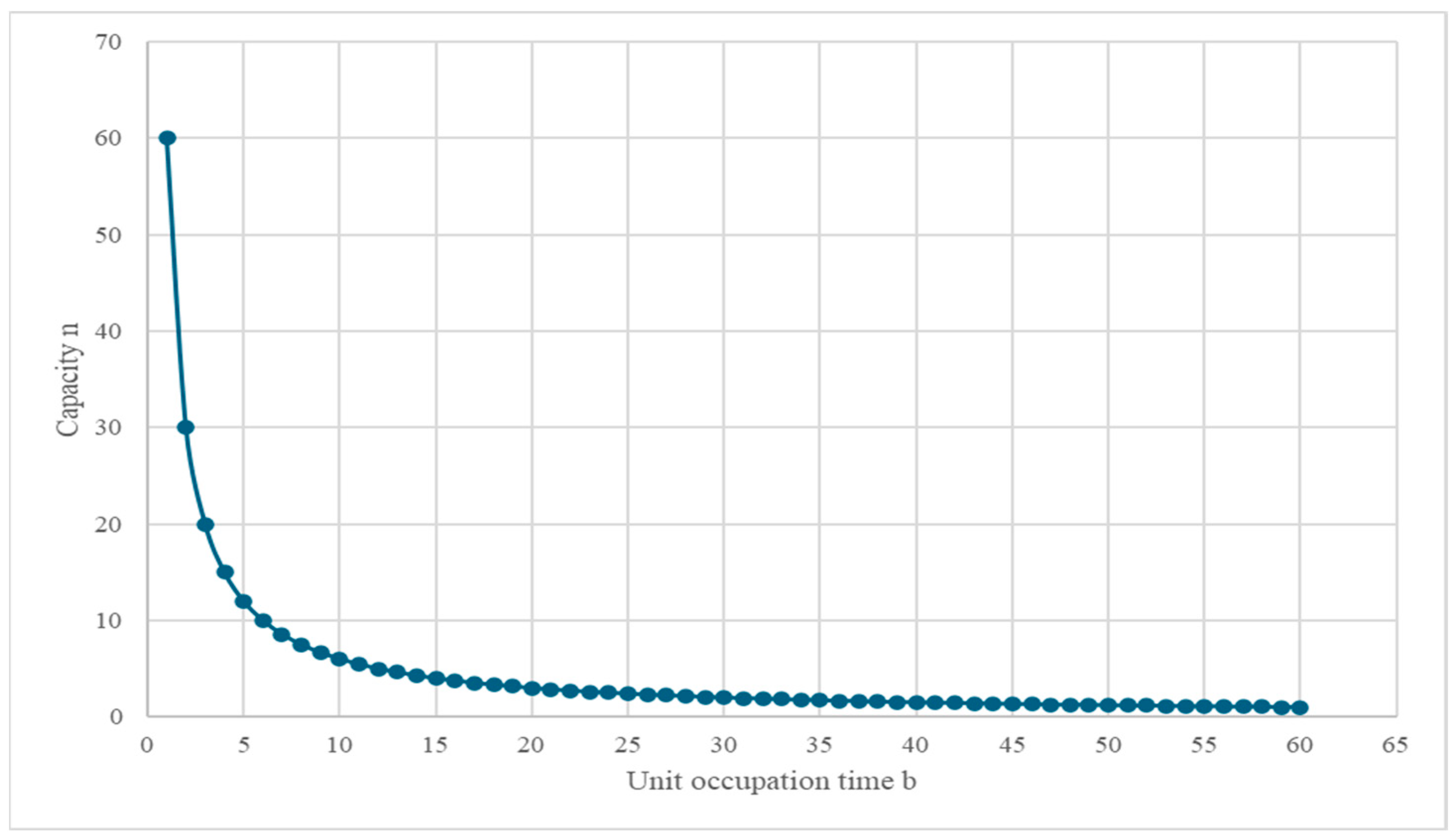
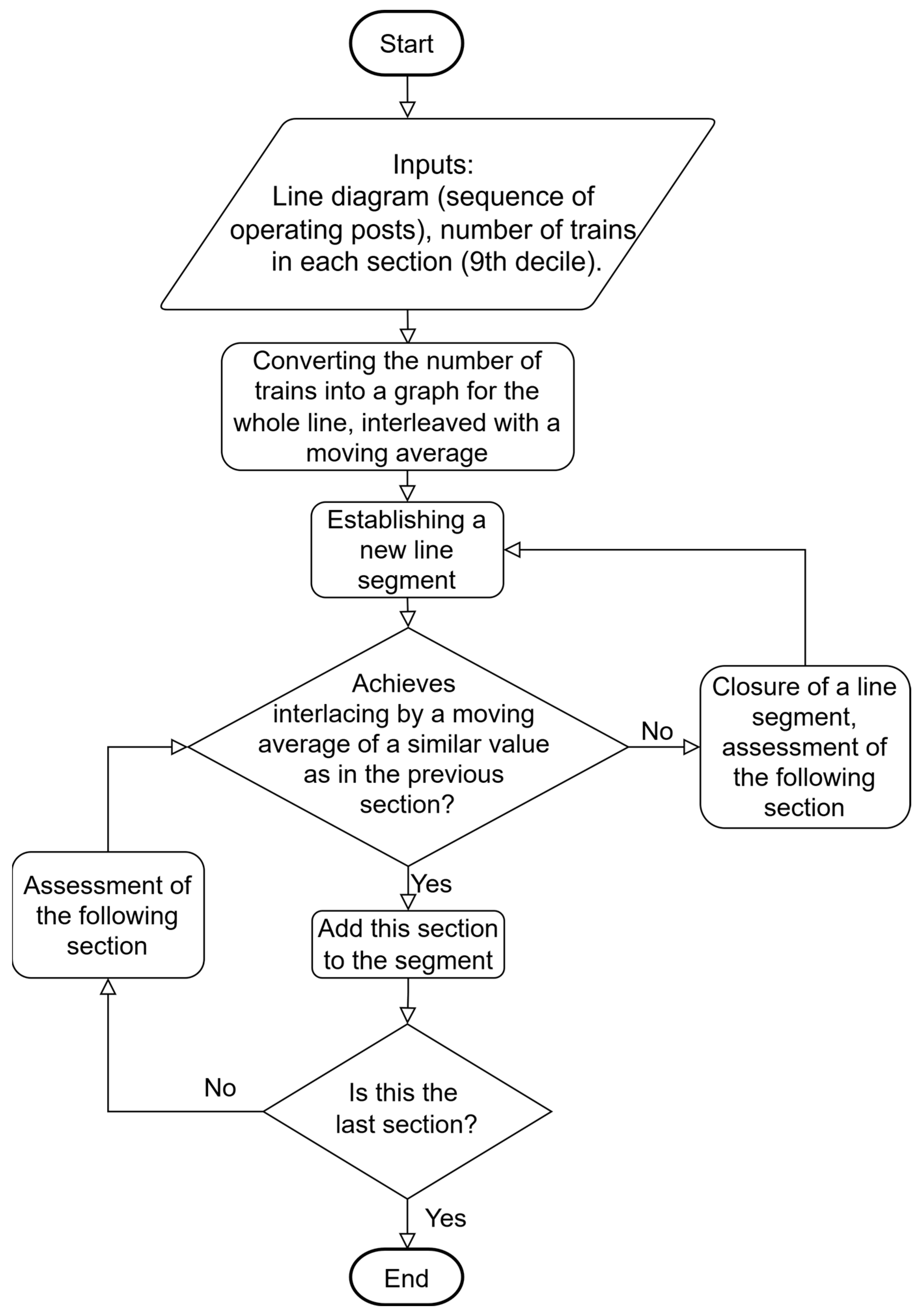
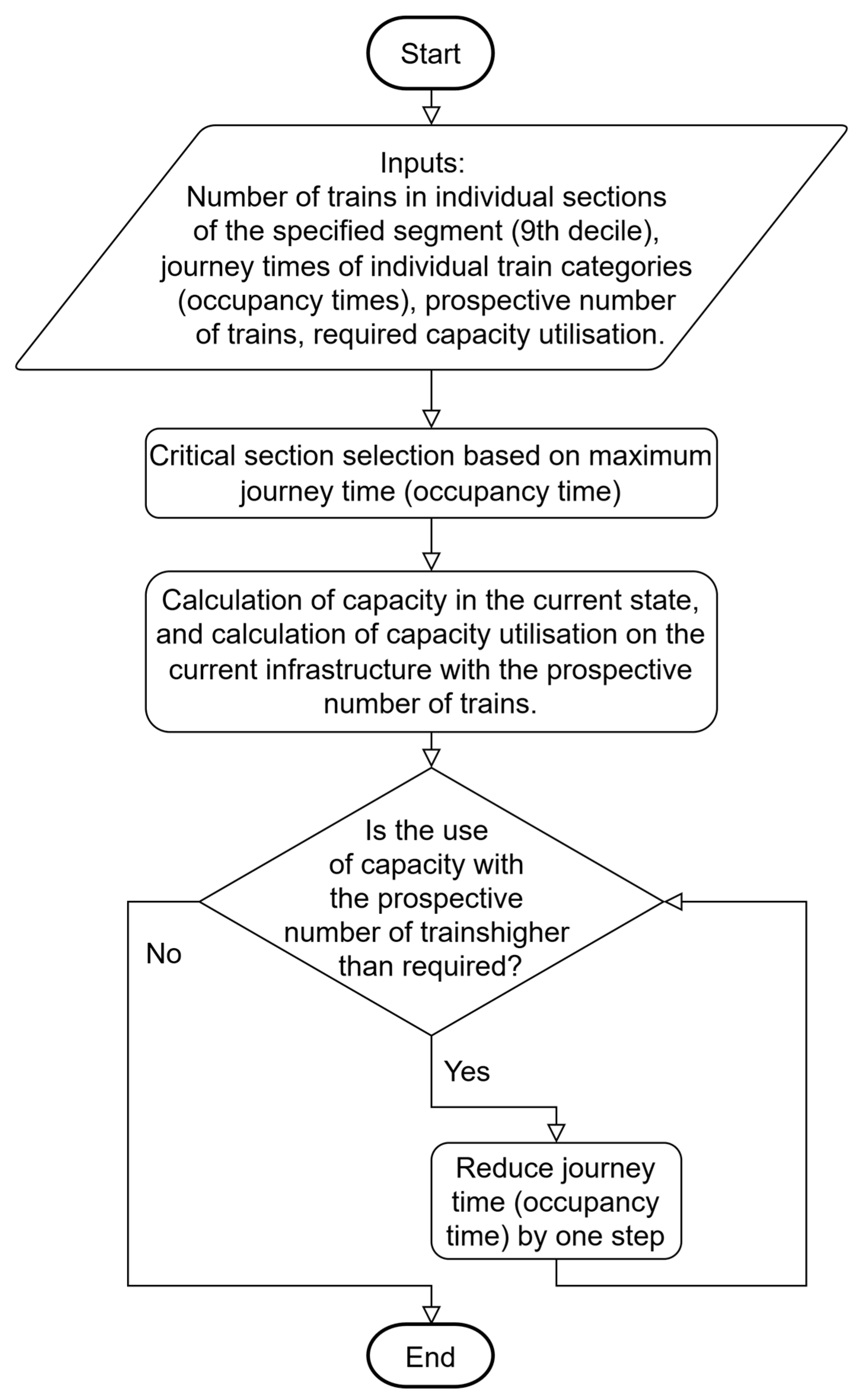
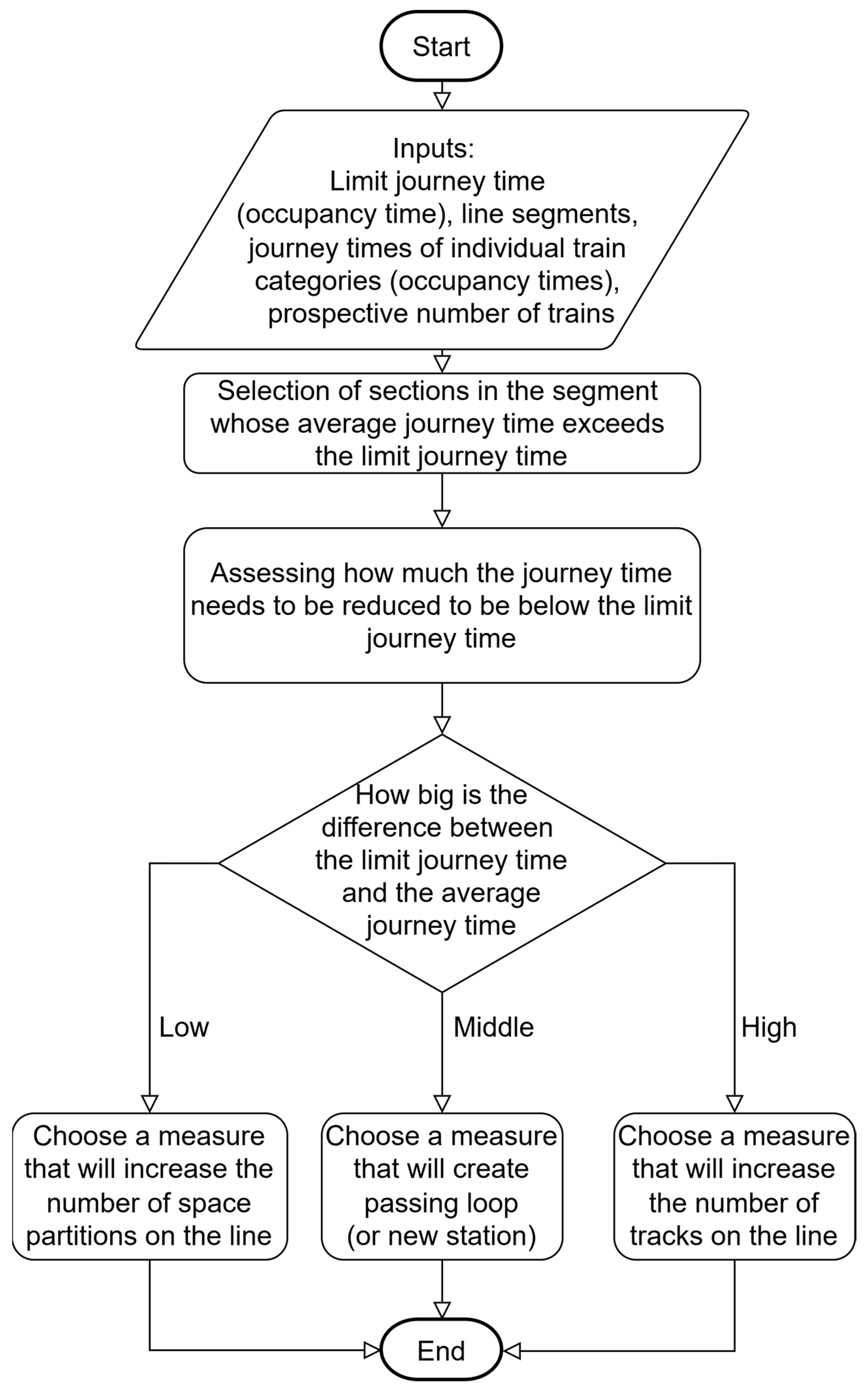
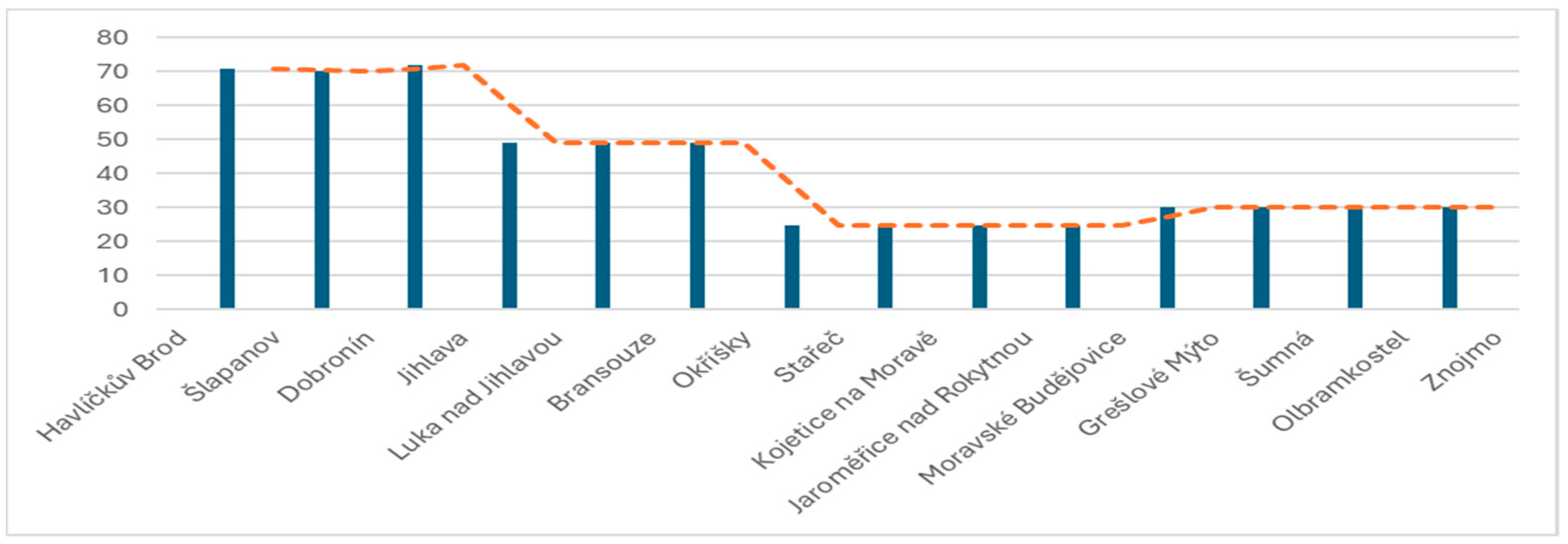
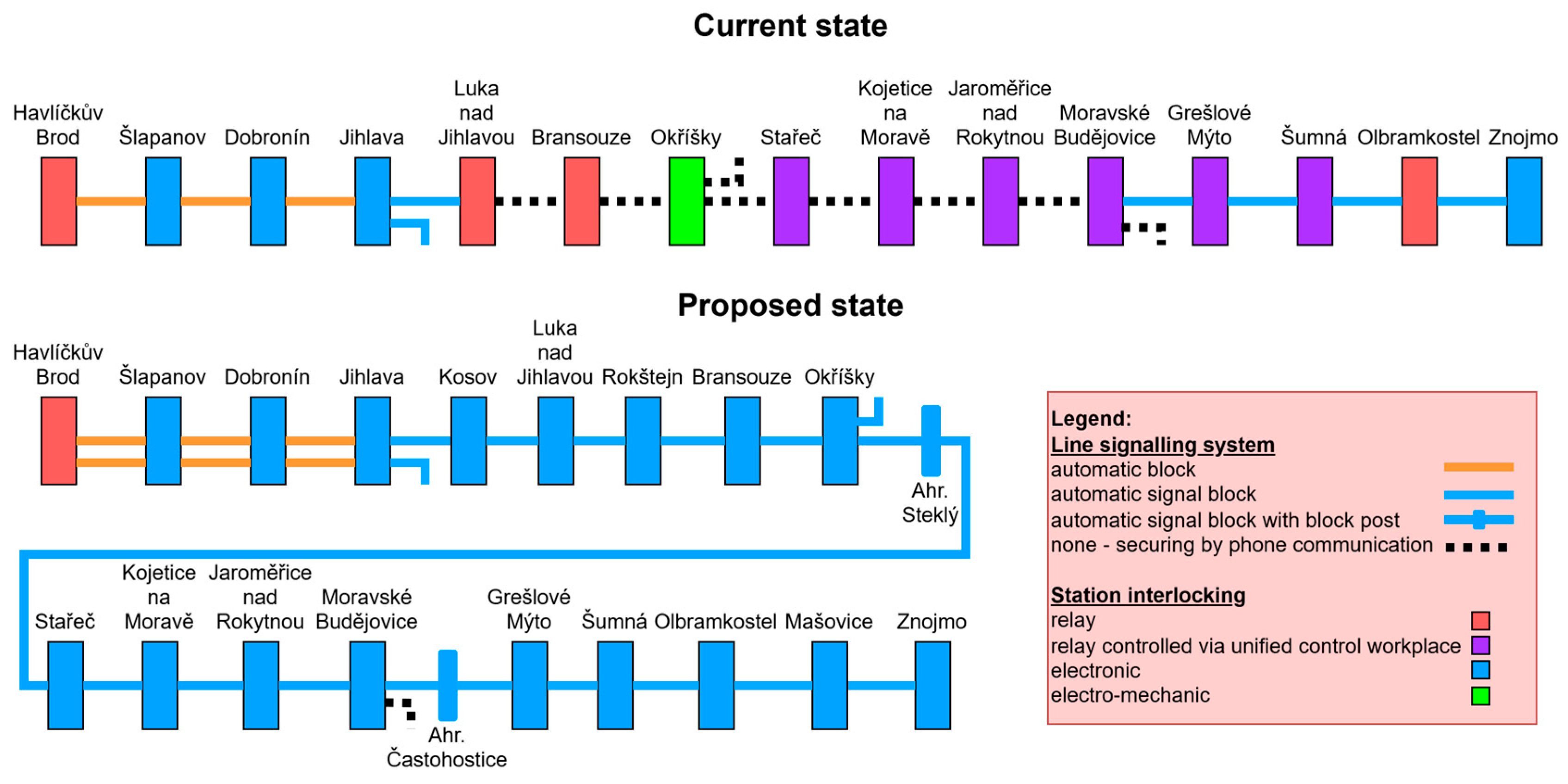
| Section/Year | 2023 | 2022 | 2021 | 2020 | 2019 | Average |
|---|---|---|---|---|---|---|
| Havlíčkův Brod | 70 | 75 | 75 | 80 | 55 | 71 |
| Šlapanov | 70 | 70 | 75 | 80 | 55 | 70 |
| Dobronín | 70 | 75 | 80 | 80 | 55 | 72 |
| Jihlava | 50 | 50 | 45 | 55 | 45 | 49 |
| Louka nad Jihlavou | 50 | 50 | 45 | 55 | 45 | 49 |
| Bransouze | 50 | 50 | 45 | 55 | 45 | 49 |
| Okříšky | 24 | 25 | 25 | 25 | 25 | 24.8 |
| Stařec | 24 | 25 | 25 | 25 | 25 | 24.8 |
| Kojetice na Moravě | 24 | 25 | 25 | 25 | 25 | 24.8 |
| Jaroměřice nad Rokytnou | 24 | 25 | 25 | 25 | 25 | 24.8 |
| Moravské Budějovice | 30 | 30 | 30 | 35 | 25 | 30 |
| Grešlové Mýto | 30 | 30 | 30 | 35 | 25 | 30 |
| Šumná | 30 | 30 | 30 | 35 | 25 | 30 |
| Olbramkostel | 30 | 30 | 30 | 35 | 25 | 30 |
| Znojmo |
| Direction/Category | Znojmo | Havl. Brod | Average | Limiting Journey Time | ||||
|---|---|---|---|---|---|---|---|---|
| Os | R | Pn | Os | R | Pn | |||
| Havlíčkův Brod | 9 | 7 | 12.5 | 9.5 | 7.5 | 10 | 9.3 | 5 |
| Šlapanov | 8 | 6 | 12.5 | 8 | 6 | 8 | 8.1 | |
| Dobronín | 9 | 6 | 13 | 8.5 | 6.5 | 10 | 8.8 | |
| Jihlava | 11.5 | 11.5 | 13 | 12.5 | 10 | 16.5 | 12.5 | 8 |
| Louka nad Jihlavou | 10.5 | 7.5 | 8.5 | 11.5 | 7.5 | 10.5 | 9.3 | |
| Bransouze | 9 | 7.5 | 13 | 9 | 8 | 8.5 | 9.2 | |
| Okříšky | 10 | 7.5 | 14 | 9.5 | 8 | 10 | 9.8 | 9 |
| Stařec | 6.5 | 5.5 | 9.5 | 6.5 | 5.5 | 13.5 | 7.8 | |
| Kojetice na Moravě | 8 | 7 | 9.5 | 9 | 7 | 13.5 | 9.0 | |
| Jaroměřice nad Rokytnou | 9 | 7.5 | 8.5 | 8.5 | 7 | 7 | 7.9 | |
| Moravské Budějovice | 12.5 | 9.5 | 11.5 | 12.5 | 9 | 19 | 12.3 | |
| Grešlové Mýto | 7 | 6 | 12 | 7 | 6.5 | 9 | 7.9 | |
| Šumná | 6.5 | 6 | 7.5 | 7 | 6 | 14.5 | 7.9 | |
| Olbramkostel | 13.5 | 12 | 12 | 14 | 12 | 29 | 15.4 | |
| Znojmo | ||||||||
| Segment | Prospective Number of Trains for a Given Period | Capacity in Current State (with Most Unfavourable Journey Time) | Capacity Utilisation | The Most Unfavourable Journey Time | Target Capacity Utilisation | Future Capacity Utilisation | Limiting Journey Time |
|---|---|---|---|---|---|---|---|
| NVYHL | n | KVYHL | bn | Kp | Kb | blim | |
| Havl. Brod–Jihlava | 27 | 19.2 | 140% | 12,5 | 60% | 56% | 5 |
| Jihava–Okříšky | 16 | 14.55 | 110% | 16,5 | 55% | 53% | 8 |
| Okříšky–Znojmo | 13 | 17.14 | 75% | 14 | 50% | 49% | 9 |
Disclaimer/Publisher’s Note: The statements, opinions and data contained in all publications are solely those of the individual author(s) and contributor(s) and not of MDPI and/or the editor(s). MDPI and/or the editor(s) disclaim responsibility for any injury to people or property resulting from any ideas, methods, instructions or products referred to in the content. |
© 2025 by the authors. Licensee MDPI, Basel, Switzerland. This article is an open access article distributed under the terms and conditions of the Creative Commons Attribution (CC BY) license (https://creativecommons.org/licenses/by/4.0/).
Share and Cite
Gašparík, J.; Vyhnanovský, M.; Vojtek, M.; Nachtigall, P.; Dedík, M. A New Methodology for Optimising Railway Line Capacity: Improving Infrastructure for Sustainable Transport. Sustainability 2025, 17, 9101. https://doi.org/10.3390/su17209101
Gašparík J, Vyhnanovský M, Vojtek M, Nachtigall P, Dedík M. A New Methodology for Optimising Railway Line Capacity: Improving Infrastructure for Sustainable Transport. Sustainability. 2025; 17(20):9101. https://doi.org/10.3390/su17209101
Chicago/Turabian StyleGašparík, Jozef, Marek Vyhnanovský, Martin Vojtek, Petr Nachtigall, and Milan Dedík. 2025. "A New Methodology for Optimising Railway Line Capacity: Improving Infrastructure for Sustainable Transport" Sustainability 17, no. 20: 9101. https://doi.org/10.3390/su17209101
APA StyleGašparík, J., Vyhnanovský, M., Vojtek, M., Nachtigall, P., & Dedík, M. (2025). A New Methodology for Optimising Railway Line Capacity: Improving Infrastructure for Sustainable Transport. Sustainability, 17(20), 9101. https://doi.org/10.3390/su17209101






